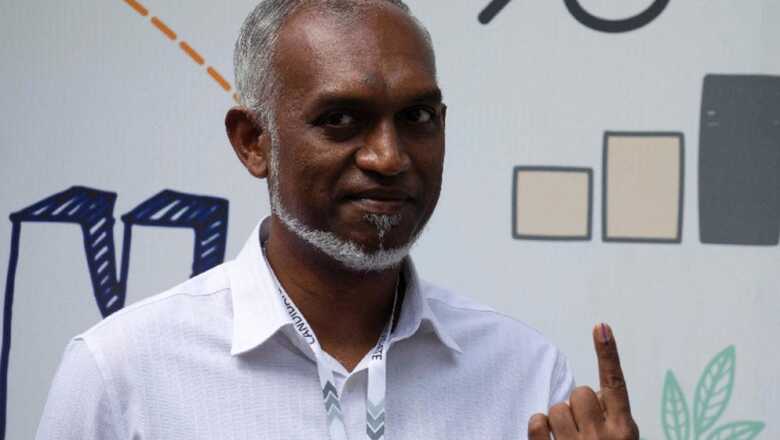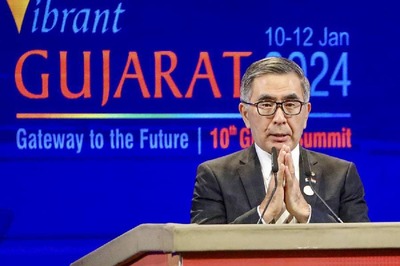
views
India’s ‘Neighbourhood First’ and Maldives ‘India First’ policies are on the brink of dissolution as the just concluded election of Mohamed Muizzu in the Maldives has opened a new chapter in the China-Maldives relationship. China’s state media has projected Muizzu’s electoral victory as a game-changer for Beijing and a setback to both Washington and New Delhi. “India suffers major diplomatic setback,” read one headline in Beijing Daily, the Chinese capital’s official newspaper, which identified the United States and India as China’s only two strategic competitors in the Indian Ocean.
But Maldives is already in a vice-like grip of the Chinese. The Sinamalé Bridge, originally known as the China-Maldives Friendship Bridge, was fully funded by China under its Belt and Road Initiative (BRI) and has become a symbol of Beijing’s crafty debt-trap diplomacy. Reportedly, the Maldives is neck deep in debt, owing $935 million in sovereign guarantees on Chinese company loans and an additional $600 million directly to Beijing. The figure according to other estimates might be as much as $3 billion, a massive amount of debt for a tourism-dependent, island nation, with a gross domestic product of just $4.9 billion.
Obviously, under Chinese pressure, Muizzu has commenced his rule by asking India to withdraw its minuscule force of 77 soldiers, maintaining two Dornier aircraft. The removal of Indian soldiers was one of the election pledges of Muizzu, despite India’s generous support to the Maldives. In May 2023, India’s defence minister laid the foundation for a new harbour project west of Malé, funded by India, and in the south, India built a new police training academy and a drug rehabilitation centre. India is also the largest tourist source market for Maldives, claiming the highest spot, with 101,348 Indian tourist arrivals as of June 14, 2023. Despite such overwhelming support for the Maldives, the recent elections were won by Muizzu on a high-decibel “India Out” election campaign.
The strategic location of Maldives lies in the fact that it is made up of 1,200 coral islands in the Indian Ocean located on the main shipping route between the East and the West. Chinese State Councillor and Foreign Minister Wang Yi visited three strategic island states — the Comoros, Maldives, and Sri Lanka — recently in January 2022, an expedition to explore bringing the Indian Ocean under Chinese hegemony.
Wang was on a mission to explore the prospects of resurrecting the Ming maritime expeditions led by Admiral Zheng He (1371–1433) in the early fifteenth century on Indian Ocean diplomacy, trade, and cross-cultural interactions. The dominance of the powerful Ming navy stamped not only a militaristic aspect to the Indian Ocean region, but also opened up state-controlled commercial activity in the maritime world that extended from Ming China to the Swahili coast of Africa. Back on Wang’s mind must have been the more interesting fact that it was in 1406 CE that the fearsome seven-foot Mongol warrior, Admiral Zheng He, set foot on the shores of Calicut, in Kerala. In the geographic profile of the Indian peninsula, Calicut has a queer reputation for being an easy conduit for foreign pirates and traders. After Zheng He, another pirate who would enter Calicut with ease would be the Portuguese buccaneer Vasco da Gama in 1498.
The ambitious Zheng He led the largest ships, then in service in the world, on seven voyages of exploration in the Indian Ocean region, directed at the Malabar Coast, Sri Lanka, and even far of Bengal. Admiral Zheng symbolised the Yongle emperor’s aim to establish hegemony over “all the known world under the Heaven” or the ‘Tianxia’. It is this same spirit to dominate all the known world under the Heavens that has gripped Premier Xi Jinping and explains his naval incursions ranging from the South China Sea to the East China Sea and the Taiwan Strait. He is following the footsteps of Admiral Zheng He by sending the satellite tracking vessel Yuan Wang 5 on August 16, 2023, to Sri Lanka’s southern Hambantota Port. The military-capable vessel is misleadingly labelled as a “marine scientific research” vessel.
There are other innumerable Chinese “fishing vessels” plying in the Indian Ocean, which apart from hunting for seafood, would be keeping track of the lucrative drug-trafficking trade happening out at sea. The hyper-active Southern Route, a well-established maritime path for opioid smuggling in the Indian Ocean region, extends from the Makran coast all the way down south to the Comoros islands, also known as the “Perfumed Islands.”
More than 140,000 vessels tracked with an Automatic Identification System (AIS) cross the Indian Ocean every year, together with countless smaller vessels not required to carry an AIS, making the Indian Ocean among the most transited oceans in the world. It is also a pivotal maritime trading route, with around half the world’s container vessels, one-third of bulk cargo traffic and two-thirds of global oil shipments crossing its waters. Chinese naval presence in the Indian Ocean Region (IOR) would mean fulfilling the Yongle Emperor’s ambition to establish a Chinese presence and impose imperial control over the Indian Ocean trade.
India’s deep concern would be safeguarding the Lakshadweep Islands from China’s prying eyes. These islands are located 200 to 440 km (120 to 270 mi) off the Malabar Coast of India. Major drug seizures have been made in this region by the Indian Navy and Coast Guard in recent times. If the IOR comes under Chinese sway, they would not only have full control of the “Southern Route” but also the “Smack Track”, the name given to another drug route in the Western Indian Ocean, which connects the northern coast of the Arabian Sea to the Southern-Eastern African coast, eventually ending in European markets, and the “Hash Highway”, yet another major drug route linking the western Indian Ocean, Arabian Sea and Gulf of Aden.
A study published in 2021, ‘Changing Tides – The Evolving Illicit Drug trade in the Western Indian Ocean’, Global Initiative against Transnational Organised Crime (GI-TOC), an independent civil-society organisation headquartered in Geneva, has detailed the deleterious impact of heroin trafficking over the “Southern Route” on the island nations in the Western Indian Ocean (Mauritius, Seychelles, Madagascar, Comoros, French territories of Mayotte and Reunion). The present-day drug trafficking in the IOR is heavily controlled and dominated by Pakistani drug cartels, and of course, the Inter-Services Intelligence (ISI), but a Chinese assertion of maritime supremacy in the ocean can mean the takeover of the drug trade from Pakistan or entering into active collaboration with Pakistan to inflict the scourge of narco-terrorism on non-cooperating nations.
Zheng died at sea and was presumably buried off the coast of Calicut in the spring of 1433. Over 690 years have passed, and Xi Jin Ping would love to resurrect the legend of Admiral Zheng He, who once criss-crossed the Indian Ocean at will, with Calicut as his base.
The writer is a retired officer of the IRS and the former director-general of the National Academy of Customs, Indirect Taxes & Narcotics. Views expressed in the above piece are personal and solely that of the author. They do not necessarily reflect News18’s views.



















Comments
0 comment